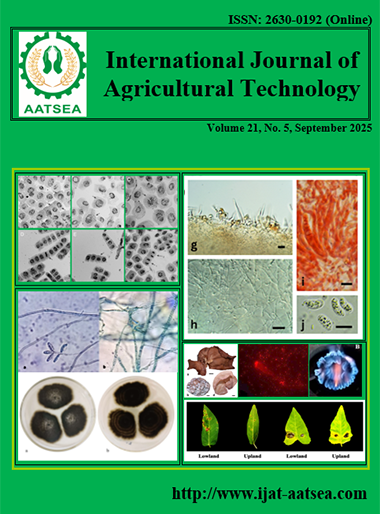Effect of composted plant based and animal derived materials on Chinese kale (Brassica oleracea var. alboglabra) performance in raised beds.
Main Article Content
Abstract
The application of organic planting materials influenced the physicochemical properties of growing media and significantly affected the growth and yield of Chinese kale cultivated in raised beds. Composted animal manures, particularly porcine and poultry manure, provided higher nitrogen and phosphorus levels, enhancing vegetative growth. Among the plant-based materials, rain tree leaves contained the highest nitrogen content; however, high nitrogen alone did not guarantee optimal growth, emphasizing the importance of nutrient balance and physical media structure. Rice husk biochar improved porosity, bulk density, and water-holding capacity, yet failed to achieve the highest yield when applied alone. The combination of filter cake or old mushroom lumps with porcine manure led to superior plant height, stem diameter, canopy width, leaf number, and leaf size. These treatments also showed higher leaf greenness, highest fresh and dry biomass, and lower root-to-shoot ratios, reflecting efficient biomass allocation toward harvestable parts. Although plant-based and animal-based materials showed significant individual effects, their interaction was not statistically significant, suggesting additive rather than synergistic effects. The superior performance of magnesium-rich materials such as filter cake highlighted the role of magnesium in chlorophyll synthesis and leaf development. Overall, integrating nutrient-dense animal manures with structurally beneficial plant-based materials improved the fertility and physical quality of growing media, resulting in enhanced growth and yield of Chinese kale. These findings demonstrated the potential of locally available organic resources, particularly combinations of porcine manure with filter cake or mushroom waste, as viable alternatives to chemical fertilizers for sustainable leafy vegetable production in raised bed systems.
Article Details

This work is licensed under a Creative Commons Attribution-NonCommercial-NoDerivatives 4.0 International License.
References
Edwards, C. A. (2004). Earthworm Ecology. 2nd ed. CRC Press.
Bangkokbiznews (2020). Fruits and vegetables that contain 100 percent pesticide residues. Retrieved from https://www.bangkokbiznews.com/health/
Bhattacharyya, R., Kundu, S., Sharma, A. R. and Singh, R. K. (2015). Relative efficacy of organic amendments for improving growth and yield of vegetable crops. Sustainable Agriculture Reviews, 14:129-161.
Chen, B., Zhou, D. and Zhu, L. (2017). Use of biochar for sustainable agriculture: Benefits and environmental impacts. Journal of Soil Science and Plant Nutrition, 17:553-565.
Inthasan, J., Suwanpingka, T. and Dechjiraratthanasiri, C. (2023). Effects of sugarcane filter cake on soil chemical properties of soil series group No.35. Journal of Agriculture, 39:59-70.
Information and communication technology center of Department of Agriculture extension. (2019). Retrieved from http://www.agriinfo.doae.go.th/year63/plant/rortor/veget/
Khwunsakun1, C. (2022). Research and development of growing bench for quality vegetables production. Agriculture and Technology Journal, 3:60-74.
Lehmann, J. and Joseph, S. (2015). Biochar for environmental management: Science, Technology, and Implementation. 2nd Edition. Routledge.
Lesing, S. and Anugoolprasert, O. (2016). Efficacy of high-quality organic fertilizer on growth and yield of Chinese kale. Thai Science and Technology Journal, 24:320-332.
Liu, X., Zhang, Y., Han, W., Tang, A., Shen, J., Cui, Z. and Zhang, F. (2018). Enhanced crop yields and soil quality improvements under organic amendments in intensive agriculture: a meta-analysis. Agronomy Journal, 110:1-11.
Lukrak, N and Athinuwat, D. (2013). Problems and barriers in changing to organic vegetable production of Ratchaburi farmers who qualified in the organic farming development project. Thai Journal of Science and Technolog, 2:125-133.
Miernicki, E. A., Lovell, S. T. and Wortman, S. E. (2018). Raised beds for vegetable production in urban agriculture. Urban Agriculture & Regional Food Systems, 3:180002.
Poonpakdee, C. and Onthong, J. (2021). Magnesium fertilizer response of maize grown in growing media. Journal of Agri. Research and Extension, 38:1-14.
Sangchote, H. (2008). Effects of leaf-litter decomposition of forest and fruit tree species on soil chemical properties. (Master Thesis). Chiang Mai University, Thailand.
Srisaikham, S. and Rupitak, Q. (2023). Utilization of rice husk biochar and filter cake combined with manure fertilizers on growth and chlorophyll content of four melon cultivars in greenhouse condition. Science and Technology Research Journal. Nakhon Ratchasima Rajabhat University, 8:10-21.
Thailand Pesticide Alert Network (2020). Year-end bad news 2020: Thai-PAN finds 58.7% of vegetables and fruits contaminated with pesticide residues exceeding safety standards. Retrieved from https://thaipan.org/highlights/2283
Uttaradit Provincial Agriculture and Cooperative Office. (2022). Basic information about Uttaradit Province. Retrieved from https://www.opsmoac.go.th/uttaradit-dwl-files
Vanaprasert, P., Athinuwat, D. and Phonprapai, C. (2013). Effects of Crotalaria juncea and animal manure application on organic Chinese kale production. Thai Journal of Science and Technology, 2:115-124.
Zhang, H., Zhao, X., Wang, X. and Wang, G. (2020). Effects of different animal manures on nutrient availability and growth of leafy vegetables. Journal of Plant Nutrition, 43:1156-1166.


